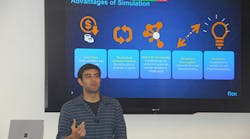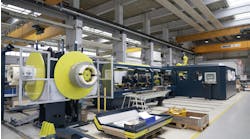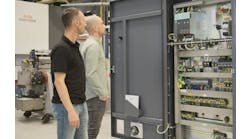Zohair Mehkri is director of digital twin at Flex.
Tell us about your company’s state-of-the-art simulation-software technology.
Zohair Mehkri, director of digital twin, Flex: Flex is a $26 billion diversified manufacturing company that makes everything from vacuum cleaners, coffee machines and autonomous car modules to diabetes equipment, industrial machinery and cloud-data-center equipment. We partner with some of the most prominent organizations worldwide to create products that create value and improve people’s lives, and simulation plays a big part in that.
Also read: Simulation sets the stage
director of digital twin, Flex
We’ve completed more than 1,000 simulation projects over the past few years. Our simulation stack consists of off-the-shelf offerings combined with middleware and proprietary software we’ve developed over the past four to five years. We utilize this powerful technology to drive operational efficiencies and simulate sites, shop floors and factory lines.
We’ve built an excellent simulation organization across our sites and are now evolving from being simulation-focused to a digital twin team.
What have been the biggest improvements to simulation-software technology in the past five years?
Zohair Mehkri, director of digital twin, Flex: That’s a great question. It’s funny because anyone that knows this market, any senior manufacturing leader, will say that, despite the buzz, simulation is not new. It’s been around since the 1970s. But in the past five years, we’ve redefined what it means to simulate processes and operations.
I would say the most considerable improvements are the availability of data and the ability to process that data. Simulation software has a linear relationship in terms of quality to compute power. So, the advent of higher-powered computers, cloud computing, higher-fidelity models and the deluge of data sources provides us with immense new capabilities.
What’s the most innovative or efficient simulation-software technology application you’ve ever seen or been involved with?
Zohair Mehkri, director of digital twin, Flex: When I think about the most efficient project I’ve been involved in, I think about our work with a medical-device vendor looking to bring a new product to market in 2020. With the power of simulation, we reiterated the product model hundreds of times over several hours, ran “what if” scenarios and tested dozens of variables. As a result, something that would have taken three months was reduced to three weeks.
We were also able to optimize scheduling to meet higher-than-expected demand. We initially projected roughly 5.5 million units per quarter, falling short of the 8 million requested by the customer. With simulation, we tested various scenarios and optimized scheduling to produce 8.1 million units per quarter, exceeding expectations.
Some other benefits included increasing workstation output by more than 70%, eliminating bottlenecks and optimizing cart availability by more than 20%, and delivering other essential business, operational and cost-saving benefits.
How has simulation-software technology benefitted from remote connectivity and networking?
Zohair Mehkri, director of digital twin, Flex: The COVID-19 pandemic changed the way we work forever, from the corner office to the factory floor. And remote connectivity and advances in networking played a huge part in that. These powerful tools enable colleagues and customers to see things without traveling or physically being on the factory floor.
The combination of tools helped teams answer questions far beyond optimization. Questions like:
- Can I see a model of a line?
- What does the shop floor look like?
- Can we see how changes impact output?
- Can you show a customer what the model of a line looks like without having to show them the physical line?
Remote connectivity and networking bring simulation capabilities anywhere, saving time, money and effort spent traveling and physically updating strategies.
Can you explain how improvements in simulation-software design and production have impacted industrial applications?
Zohair Mehkri, director of digital twin, Flex: The feature improvement over the past decade has been astounding. Of course, much is because of the computing power, data fidelity and increased data sources we discussed earlier. But most simulation software today goes beyond that and now infuse artificial-intelligence (AI) modules or machine-learning (ML) capabilities into the platform to bolster intelligence.
Another capability we see is the ability to tie into various data sources. In the past, it was Excel files or a structured-query-language (SQL) database. Now, we can tie into systems, databases, cloud and anything on the shop floor that has been digitized. The technology is expanding accessibility and usability.
There have also been some incredible user-interface advancements. Gone are the days when you had to program each step. Now it's drag and drop. You see a person or machine; you drag them into the simulation. So, there's been a lot of user-interface and experience improvements.
Finally, we've seen significant enhancements with various types of calculations. For example, now you can start calculating things you couldn't do before, like cross-functional calculations or how people act in a given space. We can even calculate agent-based modeling about how things in an area react to each other. These types of measures were not possible with legacy simulation software.
How do simulation-software technologies figure into digital-twin platform models being used by manufacturers?
Zohair Mehkri, director of digital twin, Flex: You can’t do a digital twin without simulation. You can have simulation without a digital twin, but you can’t do it the other way around. Simulation is the base of every digital twin project.
Think of simulation as a model of digital space. Then, when you take it a step further and start adding in other factors, like IT systems, finance programs, variables like humidity and temperature of an environment, people and physical features like pipes and walls, that’s a digital twin.
When will simulation-software technology become IT-friendly enough that engineers/IT professionals are no longer required for installation and operation?
Zohair Mehkri, director of digital twin, Flex: This will take a couple more years. IT teams are incredible technology generalists. These teams create, maintain, develop, secure and store applications and associated data that belong to a specific organization. And they're very good at it. They keep organizations running smoothly.
Simulation was designed for manufacturers and engineers to mirror digital spaces and allow for increased efficiency, time savings and throughput. And it's good at accomplishing this task.
Our IT team at Flex is very supportive and collaborative. We've had a very tight partnership. So, while I think we're a couple of years away from IT-friendly simulation, in the interim, close collaboration between IT and engineering can bridge many of the gaps.
What future innovations will impact the use of simulation-software technology in manufacturing operations?
Zohair Mehkri, director of digital twin, Flex: Three innovations will impact the future of simulation and digital-twin technology.
The first relates to consumption: how will simulation and digital twins be consumed? Typically, that's on a high-powered computer with 20 people crowded around one monitor, and that's not going to be the case in the future. Our team is hyper-focused on consumption and working on displaying this tech on a computer, phone, tablet and even headset where augmented and virtual reality intersect.
The second revolves around how digital twins and simulation start to increase in terms of computing and scale. This means that you'll be able to tie in even more systems, data sources and applications than you could ever imagine doing so before.
The final innovation is where these technologies fit in the metaverse and dataverse (Figure 1). In particular, how it enables the metaverse and creates new capabilities in the dataverse. It's still early days for every organization for this application, but it will be interesting to see the role simulation and digitization play in these areas.






